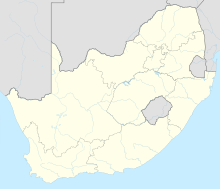| Action at Sihayo's Kraal | |||||||
|---|---|---|---|---|---|---|---|
| Part of the Anglo-Zulu War | |||||||
 A depiction of the action, British Lieutenant-General Lord Chelmsford observing in the centre foreground | |||||||
| |||||||
| Belligerents | |||||||
|
| Zulu Kingdom | ||||||
| Commanders and leaders | |||||||
|
| Mkumbikazulu kaSihayo † | ||||||
| Strength | |||||||
| 200-300 warriors | ||||||
| Casualties and losses | |||||||
| 2 NNC men killed; 20 NNC men and 3 officers and NCOs wounded | 30 killed, 4 wounded | ||||||
Approximate location in present-day South Africa | |||||||
The 12 January 1879 action at Sihayo's Kraal[nb 1] was an early skirmish in the Anglo-Zulu War. The day after launching an invasion of Zululand, the British Lieutenant-General Lord Chelmsford led a reconnaissance in force against the kraal of Zulu Chief Sihayo kaXongo. This was intended to secure his left flank for an advance on the Zulu capital at Ulundi and as retribution against Sihayo for the incursion of his sons into the neighbouring British Colony of Natal.
En-route to the kraal the British force found a small party of Zulus in a horseshoe-shaped gorge. A frontal assault was launched by auxiliary troops from the Natal Native Contingent (NNC), supported by British regulars, while a mixed unit of mounted infantry moved onto the high ground to the rear of the Zulus. After the NNC attack faltered the regulars reinvigorated the attack and defeated the Zulus in the gorge. The mounted force engaged around sixty Zulus on the high ground and drove them off. The Zulu force suffered losses of 40 killed, 4 wounded and at least 3 captured. The British lost 2 members of the NNC killed and 22 wounded.
After their victory the British moved on Sihayo's Kraal, which they found to be undefended. After burning it down they returned to their camp. The action is believed to have led Cetshwayo to attack Chelmsford's force in preference to the two other British columns operating in Zululand. Much of Chelmford's column was destroyed at the Battle of Isandlwana ten days later.
- ^ Smith 2014, p. 29.
- ^ Knight 1992, p. 63.
- ^ Knight 2004, p. 77.
- ^ Knight 1992, p. 37.
- ^ Greaves 2012b, p. 30.
- ^ Smith 2014, p. 25.
- ^ Snook 2010, p. 51.
Cite error: There are <ref group=nb> tags on this page, but the references will not show without a {{reflist|group=nb}} template (see the help page).
